Services on Demand
Journal
Article
Indicators
-
 Cited by SciELO
Cited by SciELO -
 Access statistics
Access statistics
Related links
-
 Similars in
SciELO
Similars in
SciELO  uBio
uBio
Share
Revista de Biología Tropical
On-line version ISSN 0034-7744Print version ISSN 0034-7744
Rev. biol. trop vol.52 n.4 San José Dec. 2004
A twelve-month field study of the West African Thrush Turdus pelios (Passeriformes:Muscicapidae).Part 1:food and feeding ecology
Akinsola I.Akinpelu &Oluseye A.Oyedipe
Department of Zoology,Obafemi Awolowo University,Ile-Ife,Nigeria;sholaakinpelu@yahoo.com
Received 19-VII-2002. Corrected 10-IX-2003. Accepted 07-XII-2004.
Abstract:The feeding ecology of Turdus pelios was studied from field observations and gizzard contents. Quantitative data on feeding were obtained from repeated standard "fixed route "walks and observational points at seven sites from January to December 1998 on 5065ha at the Obafemi Awolowo University campus,Ile-Ife (7 º20 N,4 º33 E).Walks (each lasting about two hours)were started at various times of the day between 7.00 and 16.45 h.A total of 100 walks were made and binoculars were used to observe all feeding activities during 10 minutes at each site.Each feeding record included food type,method of feeding and reaction with con-specifics at feeding sites.Gizzards from mist-netted specimens were also studied.These birds fed most commonly twice a day between 06.00-9.30hr in the morning and between 17.00-18.30hr in the evening.Field observations showed that about 62%of the diet consisted of plant matter.The prey items were earthworms and terrestrial arthropods, of which orthopterans alone constituted 45%of the total.The prey size consumed by both sexes overlapped extensively:differences in prey size were significant only for spiders. Rev. Biol. Trop. 52(4):1001-1007.Epub 2005 Jun 24.
Key words:Turdus pelios ,feeding ecology,prey item,prey size,bill length,gizzard,plant matter,Nigeria.
The thrush family (Muscicapidae)is made up of three hundred and six species belonging to forty-five genera and the best known of these is genus Turdus .The West African Thrush (Turdus pelios )can be distinguished from other members of the genus by the brown colour above,different from the underwing, and part of the flanks having orange-chestnut colour.The bill is bright yellow and is mainly a ground feeder.It is a shy and solitary bird with an alert and brisk manner.
Food,the sole source of energy,is involved in the replacement of wornout tissues and general well being of the birds. Apart from these effects,food also affects the geographical distribution and reproductive cycle of the birds (Earle 1981,Akinpelu 1992, 2004).Jordano (1984)reported that Turdus species are quantitatively the most important Juniperus sp.seed dispersers among frugivorous birds of Spain.In these birds the food is passed through the digestive tract rapidly with only the pulp of the fruit being partially digested (Pough et al.1989).
This paper examines in detail the feeding ecology of T.pelios especially the feeding times,methods of food collection,feeding positions and food composition.This will form part of the basis of an ecological study of this group of birds in the forested area of Nigeria.
Material and methods
Quantitative data on feeding were obtained during the study from repeated standard "fixed route "walks and observational points as at seven sites from January to December 1998 on 5065ha at the Obafemi Awolowo University campus,Ile-Ife (7 º20 N,4 º33 E).Walks were started at various times of the day between 7.00 and 16.45 h,each lasting about two hours.A total of 100 walks were made and binoculars were used to observe all feeding activities during 10 minutes at each site.Each feeding record included food type,method of feeding and reaction with con-specifics at feeding sites.
In order to monitor and determine the gizzard contents,a bigger number of birds was collected during the last week of each month. Mist-netted bird specimens were prepared within a few hours of collection, and gizzards were removed, labelled and stored in 70% ethanol.The contents were examined twice,at 40x and 100x with a standardized binocular microscope.Prey items were identified to order what are believed to be "ecologically significant " categories (e.g.egg cases,larvae etc..)using Borror et al.(1981)and a reference collection of representative and distinctive body pieces from insects taken from the study site.
Distinctive pieces from the gizzards were matched,sorted,identified and then divided by the actual number of pieces found in a whole prey item.For instance,mandibles of ants, orthorpterans and other insects,and fangs of spiders were matched and divided by two, beetle numbers were determined by counting the number of matching elytra and dividing by two, etc., so as to determine the actual number of each prey item consumed.
Percentage frequency of each prey category in the diet was calculated as the proportion of each prey category in each gizzard, averaged across all gizzards for the species. This procedure prevented one or a few particularly pre-heavy gizzards from unduly influencing the frequency distribution for the species (Rosenberg and Cooper 1990).
The mean sizes of beetles,orthopterans and spiders were compared to mean bill length of both sexes of the birds in order to determine whether significant differences occurred in the size of the prey items consumed and the sex of the birds.Mean size of prey for each category was determined for each gizzard by averaging the lengths of prey items for each prey category and by averaging the means per gizzard to determine an overall mean for each category. The mean bill length of twenty one specimens of each sex was measured with vernier calipers from the anterior edge of the nares to the tip of the culmen.Body weight was taken from the same specimens so as to determine the relationship between it and animal diet taken.
Results
The West African Thrush was observed to feed mostly in the morning between 06.00 and 09.30 hr and in the evening between 17.00 and 18.30 hr.(Table 1).A great deal of territoriality was exhibited when feeding and hence they never clustered together at a feeding site. About 4 m was observed to separate two given birds on one occasion when feeding.Foraging behavior was made up of short visits to the ground followed by a run forward,then a pause to listen,feed and a quick return to the perch in farmlands and compound lawns.
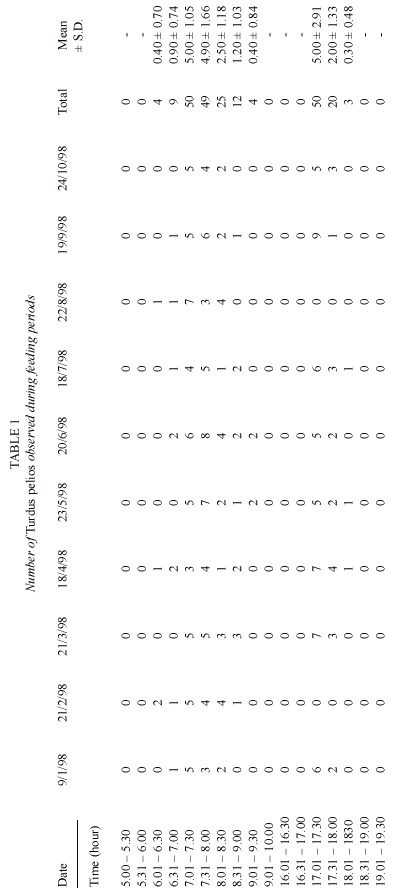
Four areas with different dominant plant species were chosen for bird sampling because they provided different habitats for the thrushes.The Biological Science had Lagerstroemia speciosa,L.indica and Acalypha s pp.The secretariat complex had Terminalia catapa ,Tridax procumbens and Sporobolus pyramidalis ;Dam area had few Casuarina s pp.and a lot of native plants such as Milicia excelsa, Newbouldia laevis,Plukenetia conophora,Parkia biglobossa,Combretum platypterum,Elaeis guinensis ,etc.,and Parks and Gardens had a variety of both native and exotic ornamental plants. The gizzard content of 42 birds, collected for 12 months were examined and identified.A large proportion of plant matter made up of Casuarina, Axonopus, Acalypha seeds,fruits and berries was found in the samples. Over half of the diet consisted of plant matter and this was supported by observations of feeding birds (Table 2)where 62%of the diet consisted of plant matter.Table 3 showed the number gizzards with recognizable animal remains.
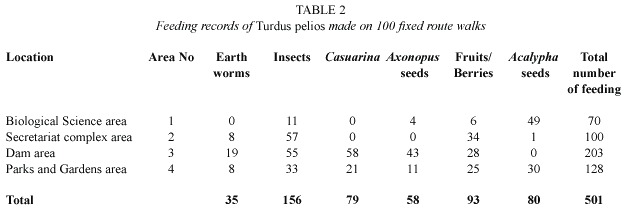
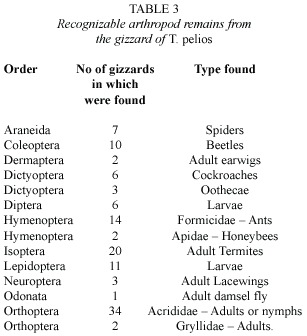
A total of 116 prey items were identified from 42 gizzards,four prey types,i.e., Orthoptera, Coleoptera, Hymenoptera and Araneae made up 72%of the prey diet,the remaining 28%being mainly Isoptera,Dictyoptera, Diptera,Neuroptera,Odonata, Lepidoptera and Dermaptera. Orthopterans were the most common prey type (Fig.1). The number of prey taxa in the cumulative samples of gizzards reached a plateau for the species,with additional taxa added less frequently with increasing sample size. By the second gizzard the four major taxa were represented in the pooled sample (Fig.2). Thus, only minor and relatively unimportant prey items (<5%of total)were added after the second gizzard.It was observed that three to six gizzards were required to represent adequately the final proportions of the major taxa.
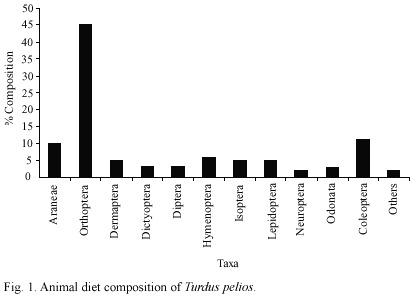
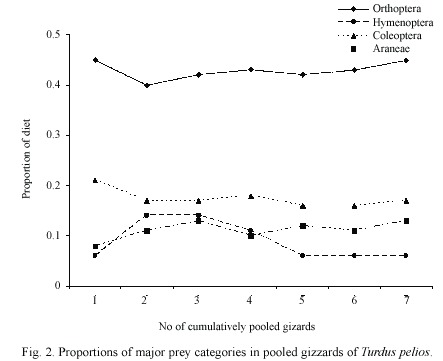
Sizes of prey items taken were significantly similar for both males and females (Fig. 3).The males ate grasshoppers and spiders that were slightly larger than those eaten by the females but there was no significant difference between the means of the lengths of the grasshoppers and spiders for both sexes when a t-test was performed (t=2.18, P>0.05; d.f.=12). Size range of the prey items in general showed extensive overlap among both sexes. Spider and beetle lengths were significantly correlated with body weight (r =0.39, p =0.02 and r =0.46,p =0.01 respectively).There were no significant correlations between bill lengths and orthoptera,spider and beetle lengths (i.e.r =0.19,p =0.17;r = 0.24,p =0.14;and r =0.26,p =0.15 respectively).
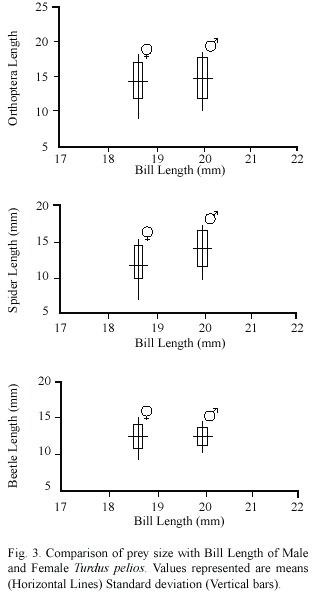
There was a significant increase in the amount of insect feeding from January to April (Table 4)which coincided sharply with the onset of the wet season in May.Although,Acalypha seeds,fruits/berries were available at all times but the most clearly seasonal foods were Axonopus and Casuarina seeds. These seeds were significantly exploited by T.pelios between May and August which were the months of highest rainfall.

The thrushes pecked insects from leaves and twigs,by shifting dead shriveled leaves with the bill,hidden insects and spiders were exposed and attacked.Insect food varied in size considerably,the largest (6.00 mm)being small grasshoppers and large caterpillars which were usually beaten against the ground before swallowing.This was then followed by bill wiping to remove leftovers.It was a common sight to see the birds going through leaf litter in search of insects and spiders. Earthworms were dug out of soft soil with the bill,picked up,and knocked down several times to immobilize them before swallowing or taken to the nest for the nestlings.
Casuarina seeds were taken directly from the cones more often before rainfall, when they were easier to ext ract from t he cones. Grass seeds were picked off panicles directly and eaten, or the grass heads may have been bent towards the ground after standing on them so as to feed on the seeds. Berries or parts of succulent fruits were picked directly from plants and swallowed whole. Fouled and cloudy water were avoided but clean and clear water were sipped before raising the bill so that the water can go down the throat.
Discussion
The West African thrush actively foraged with an alert brisk manner at sites with carpets of leaf litter free of herbaceous growth.An earlier study by Oatley (1982)confirmed similar observation on the Starred Robin Pogonocichla stellata in Natal,South Africa, where the bird preferred to feed under trees, when available,because its brown colour above and underwing coverts blended with the stem of the tree and thus camouflaged the bird when feeding at such sites.
Opportunism in resource use has been linked with temporary abundance of resources in a number of studies of diet and feeding behaviour (Wiens and Rotenberry 1979, Rosenberg et al.1982).Such studies abound in temperate environments in which there were marked seasonal flush of food,allowing different species to exploit abundant resources. However in this study when rainy season sets in (May -October)insect abundance was greatly reduced,thereby affecting the availability of insect prey items,confirming the observations of Earle and Oartley (1983)on the Orange thrush.The West African thrush then fed voraciously on decayed vegetable matter.
A large proportion of the diet (62%) consisted of plant matter comparable to 65% obtained by Earle and Oatley (1983)and orthopterans alone accounted for 45%of the prey items consumed.The species exploited, temporarily,abundant resources;the composition of diets in both sexes being similar,the prey size overlapped extensively between both sexes.The composition of the diet seemed to be seasonally dependent:during the dry season (November -April)they utilized more animal matter than plant matter and vice-versa.A difference in diet composition detected in this study was the fact that the male ate roughly one and a half times as many spiders as the femal.Possibly,males required more animal matter to aid spermatogenesis and these items are easily converted to energy required in territorial defense in the absence of carbohydrate-containing diets.Insects were never caught in flight but on the ground when sighted.
Among the sexes,differences in prey sizes were significant only for spiders.Beetle and spider lengths correlate significantly with the body weight of the birds but they differed significantly between the sexes.The importance of body weight to prey size was low since no significant relationships were found between body weight of the birds and the lengths of most of the major and minor prey items,even for each sex of the species studies.Thus body size of the bird had no significant influence on the size of prey.The identified food sources in this work was by no means exhaustive, additional studies may reveal other food items and at the same time elucidate why preys larger than orthopterans were avoided.
Acknowledgment
We express our special thanks to the Department of Zoology for the facilities provided for our use,and the herbarium unit of the Department of Botany,Obafemi Awolowo University,for the identification of the plant specimens.
Resumen
Se examina la ecología alimenticia del ave Turdus pelios en Nigeria,África.Se observó que se alimenta frecuentemente dos veces al día entre 6:00 -9:30 am y entre las 17:00 -18:30 pm.Observaciones de campo mostraron que alrededor del 62%de la dieta consite en material vegetal. Las presas fueron lombices y artropodos terrestres,de los cuales los ortópteros constituyen el 45%del total.El tamaño de las presas consumidas por ambos sexos se traslapa ampliamente,y las diferencias fueron significativas solamente respecto al tamaño de las arañas (los machos consumieron más).
Palabras clave:Turdus pelios ,ecología,alimentación, presa,tamaño de presa,molleja,material vegetal,Nigeria.
References
Akinpelu, A.I.1992.Studies on the reproductive activities of three estrildid birds (Family:Estrildidae)in Ile-Ife, Nigeria. Ph. D. Thesis. Obafemi Awolowo University,Ile-Ife. [ Links ]
Akinpelu,A.I.2004.A twelve-month field study of the West African Thrush Turdus pelios (Passeriformes: Muscicapidae) Part 2:annual cycles.Rev.Biol.Trop. 53:in press. [ Links ]
Borror,D.J.,D.M.De Long &C.A.Triplehorn.1981.An introduction to the study of insects.Saunders College Publ.,New York. [ Links ]
Earle,R.A.1981.Factors governing avian breeding in Acacia Savanna.Pietermaritzburg.Part 1:Extrinsic factors.Ostrich 52(2):65-83. [ Links ]
Earle,R.A.&T.B.Oatley.1983.Populations,ecology and breeding of the Orange Thrush at two sites in eastern South Africa.Ostrich 54:205-212. [ Links ]
Jordano,P.1984.Seed weight variation and differential avian dispersal in blackberries Rubus ulmifolius. Oikos 43:149-153. [ Links ]
Oatley,T.B.1982.The Starred Robin in Natal.Part 2: Annual cycles and feeding ecology.Ostrich 53(4): 193-221. [ Links ]
Rosenberg,K.V.,R.D.Ohmart &B.W.Anderson.1982. Community organization in riparian birds: response to an annual resource peak.Auk 99:260-274. [ Links ]
Rosenberg,K.V.&R.J.Cooper.1990.Approaches to avian diet analysis.In M.L. Morrison, C.J. Ralph, J. Verner &J.R.Jehl,Jr (eds.).Avian foraging:theory,methodology and applications.Studies in Avian Biology No:13:80-90. [ Links ]
Pough,F.H.,B.H.John &N.M.William.1989.Vertebrate life.Macmillan,New York. [ Links ]
Wiens,J.A.&J.T.Rotenberry.1979.Diet niche relationships among North American grasslands and shrubsteppe birds.Oecologia 42:253-292. [ Links ]














